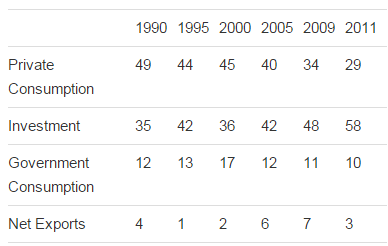CHINA AFTER THE MINOTAUR
Posted on 27th November 2012In the book’s penultimate chapter, I discussed the Soaring Dragon which, as everyone tells us, is waiting in the wings, purportedly to take over from the Global Minotaur. In my concluding remarks, written back in January 2011, I wrote: “To buy time, the Chinese government is stimulating its growing economy and keeps it shielded from currency revaluations, in the hope that vibrant growth can continue. But they see the omens. And they are not good. On the one hand, China’sconsumption-to-GDP ratio is falling; a sure sign that the domestic market cannot generate enough demand for China’s gigantic factories. On the other hand, their fiscal injections are causing real estate bubbles. If these are unchecked, they may burst and thus cause a catastrophic domestic unwinding. But how do you deflate a bubble without choking off growth? That was the multi-trillion dollar question that Alan Greenspan failed to answer. It is not clear that the Chinese authorities can.”
In the eighteen months that followed since those lines were written (in 2011), events have confirmed the projected pattern. The table below reveals that the falling rate of Chinese consumption is continuing unabated. In 2011 of every one dollar of income produced, only 29 cents entered China’s markets. With net exports making a small annual contribution to domestic demand (even though they contribute greatly to the country’s capacity to invest and, thus, boost productivity), the onus falls increasingly on investment to meet the demand shortfall. However, as suggested in the avove paragraph, this emphasis on investment is a double edged sword, as it threatens to let the Giny out of the bottle in real estate markets, where bubbles have been looming threateningly for a while now.

Indeed, in 2011 the Chinese authorities tightened up the administrative conditions for providing new housing loans, in the hope that such a move would leave productive investments unaffected while curtailing the funding of more white elephants and empty apartment blocks (which Chinese middle class professionals buy, having borrowed heavily, but leave empty in the hope of selling them more dearly later on – a standard bubble-in-the-making).
Unfortunately, while demand for housing fell, the tell-tale signs soon appeared that the government’s intervention was about to deflate not just the housing bubble but also industrial output. What tell-tale signs? The level of electicity output which, in early 2012, plataued. The last time that had happened, in 2008/9, the growth rate of industrial production declined sharply soon after, causing Beijing to stimulate the economy at a level that further suppressed the consumption ratio. To avoid this, the government is now relaxing its constraints on mortgage provision, accepting a renewed risk of a bubble in housing.
In summary, just as in Europe’s surplus countries, so too in China, the one fourth reduction in global aggregate demand occasioned by the Global Minotaur’s passing has impeded any meaningful recovery. Indeed, it has made the world we live in more precarious because the remedies attempted (stimulus in China, QE in the United States, and austerity in Europe) increase the probability that the Crisis will spawn nasty little appendages. For until and unless a global recycling mechanism rises from the Minotaur’s ashes to replace him, the world will remain an insecure, depressing place.
Recommended Content
Editors’ Picks
EUR/USD flirts with daily tops near 1.0730

The continuation of the selling pressure in the Greenback now lends further oxygen to the risk complex, encouraging EUR/USD to revisit the area of daily highs near 1.0730.
USD/JPY looks stable around 156.50 as suspicious intervention lingers

USD/JPY remains well on the defensive in the mid-156.00s albeit off daily lows, as market participants continue to digest the still-unconfirmed FX intervention by the Japanese MoF earlier in the Asian session.
Gold holds steady above $2,330 to start the week

Gold fluctuates in a relatively tight channel above $2,330 on Monday. The benchmark 10-year US Treasury bond yield corrects lower and helps XAU/USD limit its losses ahead of this week's key Fed policy meeting.
Week Ahead: Bitcoin could surprise investors this week Premium

Two main macroeconomic events this week could attempt to sway the crypto markets. Bitcoin (BTC), which showed strength last week, has slipped into a short-term consolidation.
Five Fundamentals for the week: Fed fears, Nonfarm Payrolls, Middle East promise an explosive week Premium

Higher inflation is set to push Fed Chair Powell and his colleagues to a hawkish decision. Nonfarm Payrolls are set to rock markets, but the ISM Services PMI released immediately afterward could steal the show.